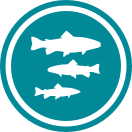Black Grouper Fish Line Drawing
Red Grouper

About the Species
Although some populations are below target levels, U.S. wild-caught red grouper is still a smart seafood choice because it is sustainably managed and responsibly harvested under U.S. regulations.

Population
Above target population level in the Gulf of Mexico. Significantly below target population level in the South Atlantic. A rebuilding plan is in place for the South Atlantic stock.

Fishing Rate
At recommended levels in the Gulf of Mexico and the South Atlantic.

Habitat Impacts
Fishing gear used to catch red grouper rarely contacts the ocean bottom and has minimal impacts on habitat.

Bycatch
Regulations are in place to minimize bycatch.
Population Status
-
There are two stocks of red grouper: the Gulf of Mexico stock and the South Atlantic stock. According to the most recent stock assessments:
-
The Gulf of Mexico stock is not overfished (2019 stock assessment), and is not subject to overfishing based on 2019 catch data. Summary stock assessment information can be found on Stock SMART.
-
The South Atlantic stock is overfished (2017 stock assessment), but is not subject to overfishing based on 2019 catch data. Summary stock assessment information can be found on Stock SMART. A rebuilding plan has been in place since 2012.
-
Appearance
- Red grouper have robust bodies with small scales.
- Their head and body are dark reddish brown, shading pink or reddish below with occasional white spots on the sides and black spots on the cheeks.
- They have large mouths with a lower jaw that often projects slightly beyond their upper jaw, with bands of slender, sharp teeth, and usually a few stout, fixed canines.
- Their large mouths allow them to eat their prey whole.
Biology
- Red grouper grow slowly, up to almost 50 inches long and more than 50 pounds.
- The oldest recorded red grouper in the South Atlantic was 26 years old and the oldest recorded in the Gulf of Mexico was 29 years old.
- They are protogynous hermaphrodites – they begin life as females and sexually mature when they reach 4 to 6 years of age. Some later transform into males, most often between the ages of 7 and 15. The proportion of males in the population increases with age.
- They spawn frequently, close to 26 times a year, in shallow waters from February through June.
- Red grouper feed on a wide variety of fish, octopus, and crustaceans, including shrimp, lobsters, and mantis shrimp.
- They are among the top predators in reef community food webs and may control some aspects of community balance in reef systems. Red grouper are unspecialized and opportunistic feeders – they eat any convenient prey. They engulf prey whole by opening their large mouths, dilating their gill covers, rapidly drawing in a current of water, and inhaling the food.
- Smaller grouper are preyed on by the same predators that eat snappers, including jacks, other groupers, sharks, barracudas, and morays. Large sharks and carnivorous marine mammals prey on adult red grouper.
Where They Live
- Red grouper are found in the western Atlantic Ocean from Massachusetts through the Gulf of Mexico and south to Brazil.
Fishery Management
- NOAA Fisheries and the South Atlantic and Gulf of Mexico Fishery Management Councils manage the red grouper fishery:
- In the South Atlantic, managed under the Snapper-Grouper Fishery Management Plan:
- Commercial fishermen must have a permit to fish, land, or sell red grouper. Managers limit the number of available permits to control the number of fishermen harvesting red grouper.
- Annual catch limits are used for red grouper in the commercial and recreational fisheries. These fisheries are closed when their annual catch limit is projected to be met.
- Both the commercial and recreational fisheries have size limits to reduce harvest of immature red grouper.
- The commercial and recreational fishing seasons are closed from January through April to protect red grouper during their peak spawning period.
- Gear restrictions are used to reduce bycatch and protect habitat.
- There are eight deep-water marine protected areas and several spawning special management zones to protect habitats. The Oculina Experimental Closed Area is closed to fishing for and possession of all snappers and groupers to protect deepwater coral habitat and the reef fish it supports.
- In the Gulf of Mexico, managed under the Reef Fish Fishery Management Plan:
- Commercial vessels must have a reef fish permit and individual fishing quota (IFQ) to harvest red grouper.
- The annual catch limit is allocated between the commercial (76 percent) and recreational (24 percent) fisheries.
- The IFQ program (catch shares) allocates the commercial catch limit among shareholders with measures to prevent fishermen from harvesting more than their individual allocation.
- To reduce bycatch, there are restrictions on the type of gear fishermen may use and where they can fish.
- Minimum size limits protect immature red grouper.
- Year-round and/or seasonal area closures for commercial and recreational sectors to protect spawning groupers.
- Commercial data reporting requirements.
- In the U.S. Caribbean:
- Annual catch limits.
- Seasonal closure from February 1 through April 30.
Harvest
- Commercial fishery:
- In 2019, commercial landings of red grouper totaled more than 2.4 million pounds and were valued at approximately $10.8 million, according to the NOAA Fisheries commercial fishing landings database.
- Gear types, habitat impacts, and bycatch:
- Commercial fishermen mainly use hook-and-line gear, including longlines and handlines, to harvest red grouper.
- Trawl gear, fish traps, and bottom longlines are prohibited in some areas to reduce bycatch. Several areas are closed to all fishing to protect snappers and groupers, including red grouper.
- Sea turtles and other reef fishes, such as snappers and groupers, can be incidentally caught while fishing for red grouper.
- In certain areas, fishermen are required to use circle hooks to improve the chance of survival of any unintentionally caught fish and to reduce turtle hookings.
- Commercial and charterboat/headboat reef fish fishermen must use appropriate release gear and follow handling protocols to increase the chance of survival for any incidentally caught sea turtles.
- Fishermen are encouraged to use venting tools or fish descenders when fish are caught showing signs of barotrauma. Barotrauma occurs when reef fish are quickly brought to the surface by hook-and-line and the gas in their swimbladders expands. Venting tools help deflate the expanded abdominal cavity, potentially reduce injury to the fish, and make it easier to return to deep water.
- Recreational fishery:
- Red grouper is a popular fish among recreational fishermen in the South Atlantic and Gulf of Mexico.
- In 2019, recreational anglers landed more than 1.9 million pounds of red grouper, according to the NOAA Fisheries recreational fishing landings database.
- In the South Atlantic:
- Annual catch limits and accountability measures.
- Bag and size limits.
- The fishery is closed during the spawning season (from January through April).
- In the Gulf of Mexico:
- Annual catch limits and accountability measures.
- Bag and size limits.
- The fishery is closed during the spawning season (from February 1 through March 31) in deep water to protect spawning aggregations.
- In the U.S. Caribbean:
- Annual catch limits.
- Seasonal closure from February 1 through April 30.
- Bag and vessel limits.
Featured News

Recreational Fishing Regulations
Commercial Fishing Regulations
Subsistence Fishing Regulations
Science Overview
Data & Maps
Black Grouper Fish Line Drawing
Source: https://www.fisheries.noaa.gov/species/red-grouper

0 Response to "Black Grouper Fish Line Drawing"
Post a Comment